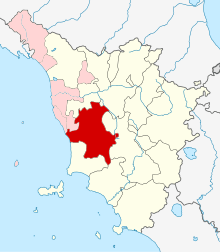Roman Catholic Diocese of Volterra
| Diocese of Volterra Dioecesis Volaterrana | |
|---|---|
|
Volterra Cathedral | |
| Location | |
| Country | Italy |
| Ecclesiastical province | Pisa |
| Statistics | |
| Area | 1,743 km2 (673 sq mi) |
| Population - Total - Catholics |
(as of 2010) 81,854 80,114 (97.9%) |
| Parishes | 88 |
| Information | |
| Denomination | Catholic Church |
| Rite | Roman Rite |
| Established | 5th century |
| Cathedral | Basilica Cattedrale di S. Maria Assunta |
| Current leadership | |
| Pope | Francis |
| Bishop | Alberto Silvani |
| Emeritus Bishops | Vasco Giuseppe Bertelli |
| Map | |
 | |
| Website | |
| www.diocesivolterra.it | |
The Diocese of Volterra (Latin: Dioecesis Volaterrana) is a Roman Catholic ecclesiastical territory in Tuscany, central Italy. It is a suffragan of the Archdiocese of Pisa.[1]
History
Volterra is an ancient Etruscan town, later conquered by the Romans. In the Carolingian period it belonged to the Marquisate of Tuscany; with the approval of Henry, son of Frederick Barbarossa, the government of it afterwards passed into the hands of the bishop, until his temporal authority was suspended by the commune. In the wars or factions of the 13th century, Volterra, being Ghibelline, was continually embroiled with the Florentines, who captured it in 1254, but obtained definitive possession of it only in 1361.
According to the Liber Pontificalis, Volterra was the birthplace of St. Linus, the immediate successor of St. Peter. Nothing is known as to its Christian origins; Eucharistus, the first bishop of Volterra of whom there is any record (495), was deposed by the pope, and Helpidius (496) was put in his place. Justus (560) was at first involved in the Schism of the Three Chapters.
Volterra was immediately subject to the Holy See until 1856, when it became a suffragan of Pisa.
References
- Amidei (1864–65). Storia Volterrana. Volterra.
Notes
External links
![]() This article incorporates text from a publication now in the public domain: Herbermann, Charles, ed. (1913). Catholic Encyclopedia. Robert Appleton Company.
This article incorporates text from a publication now in the public domain: Herbermann, Charles, ed. (1913). Catholic Encyclopedia. Robert Appleton Company.
| ||||||